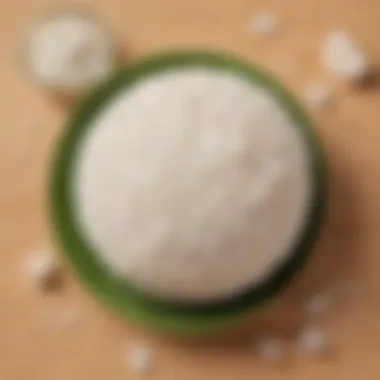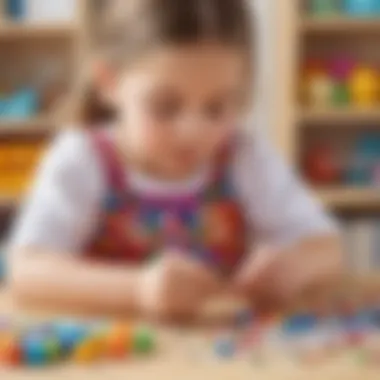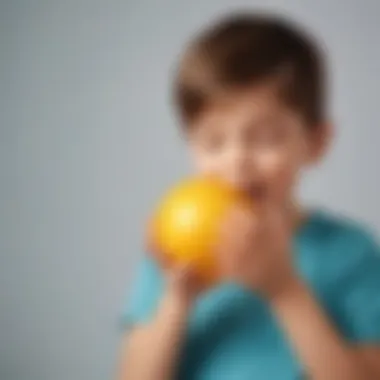Crafting a Homemade Stress Ball for Children: A Creative Guide


Science Fun Facts
Did you know that stress balls were invented in the 1980s as a tool for aiding hand therapy exercises? Originating from the healthcare field, these squishy objects have now become popular for their stress-relieving qualities among both children and adults. Stress balls come in various shapes and sizes, ranging from traditional round designs to more creative forms like fruits, animals, or emojis.
Discover the Wonders of Science
In the process of creating a homemade stress ball, children get a hands-on experience in understanding the principles of elasticity and texture. By selecting different materials like balloons, rice, flour, or slime, kids explore the concepts of physics and material science without even realizing it. Through this interactive DIY activity, they not only enhance their fine motor skills but also develop a curiosity for how things work.
Science Quiz Time
How does the texture of a stress ball affect its stress-relieving properties? A) Soft and squishy B) Hard and bouncy C) Sticky and gooey D) Rough and solid
Test your knowledge on stress balls by answering the quiz above. Embrace the fun of learning through this engaging quiz designed to challenge your understanding of stress ball creation and functionality.
Science Experiment Showcase
Engage in a fun and creative experiment to craft your homemade stress ball. Gather materials such as balloons, flour or rice, a funnel, and scissors. Follow these step-by-step instructions to create your stress-relieving tool:


- Stretch out the balloon to expand it.
- Insert the funnel into the balloon's opening.
- Slowly pour the flour or rice into the balloon through the funnel.
- Leave enough room at the top for squeezing.
- Securely tie the balloon to seal the contents inside. Remember, safety first - when using scissors, always have adult supervision to prevent accidents and ensure a safe crafting experience. Enjoy the process of making your stress ball and feel the satisfaction of creating something tactile and useful.
Introduction
In the bustling world of today, where stress and anxieties often find their way into our lives, it is crucial to equip ourselves with tools to combat these negative influences. Stress balls, simple yet effective, serve as a beacon of relief amidst the chaos. This article delves into the art of creating homemade stress balls specifically tailored for the vibrant minds of children.
With a focus on nurturing creativity and sensory development, crafting stress balls becomes a dual-purpose activity. Children, aged 6-12, can embark on this journey of creation, not just to tackle stress but also to engage their senses and unleash their artistic flair. By understanding the nuances of selecting materials, filling techniques, and customization options, this guide becomes a roadmap for both children and their guardians to navigate the sea of stress seamlessly.
A stress ball is not merely a tool to release physical tension; it embodies a therapeutic experience that young minds can appreciate. Through this DIY project, children not only relieve stress but also enhance their ability to focus and engage with their environment more intently. The introduction of stress balls into their daily routine presents a fun yet constructive way to tackle stressors, promoting holistic well-being and emotional resilience. In a world where pressures are omnipresent, these stress balls become beacons of hope, guiding children towards a path of self-care and creativity.
Materials Needed
In the realm of creating homemade stress balls for kids, the selection of materials plays a pivotal role. The materials utilized not only contribute to the functionality of the stress ball but also impact its overall sensory experience for the child. When considering the materials needed, it is essential to focus on elements that are safe, engaging, and conducive to the developmental needs of the child. By carefully choosing the right materials, parents and caregivers can facilitate a creative and educational activity for children aged 6-12.
Balloon Selection
Selecting the appropriate balloon for the homemade stress ball is a crucial decision in the crafting process. The balloon serves as the outer casing of the stress ball, providing the necessary flexibility and durability. It is imperative to opt for high-quality balloons that are resilient to prevent premature bursting. Additionally, considering the size of the balloon is essential to ensure that it is suitable for the child's grip. By choosing balloons in vibrant colors or fun patterns, the sensory appeal of the stress ball can be enhanced, making it more visually engaging for the child.


Filler Options
When it comes to filler options for the stress ball, there are several considerations to ponder. The filler material not only determines the texture and squishiness of the stress ball but also influences its weight and sensory feedback. Common filler options include flour, rice, sand, or even small foam beads. It is crucial to select a filler that is non-toxic, hypoallergenic, and safe for children to handle. Parents can encourage children to explore different filler materials to understand the tactile variations and select one that best suits their preferences.
Additional Decorations
Apart from the functional components, adding decorations to the homemade stress ball can elevate its aesthetic appeal. Children can personalize their stress balls by incorporating additional elements such as stickers, googly eyes, or glitter for a touch of creativity. These decorations not only make the stress ball visually appealing but also provide a sensory stimulant for the child. By allowing children to decorate their stress balls according to their imagination, parents can foster artistic skills and self-expression in a playful manner.
Step-by-Step Guide
Creating a stress ball at home is a fantastic activity for children, blending fun and practicality. The process of constructing a stress ball involves a few key stages, each crucial to the overall success of the project. By following the step-by-step guide meticulously, kids not only get the joy of crafting their own toy but also develop valuable skills in focus, creativity, and fine motor abilities.
- Prepare the Balloon In the initial phase, selecting the right type of balloon is essential for the stress ball's durability and texture. A latex balloon of medium size works best, ensuring it can stretch adequately to accommodate the filling without easily tearing. Kids should pay attention to the balloon's quality, opting for a sturdy material that can withstand pressure. Ensuring the balloon is clean and free of any debris or moisture is vital to the project's success.
- Fill the Balloon Once the balloon is prepped, filling it with the chosen material is the next step. Kids can experiment with various fillers like flour, rice, beans, or even playdough. The filling choice impacts the stress ball's texture and sensory experience, so children should consider their preferences before proceeding. Careful filling in a controlled manner helps prevent overfilling or spillage, ensuring a mess-free and successful creation process.
- Tie and Secure Tying the balloon securely is the final step in making a stress ball. Children should knot the balloon's neck tightly, ensuring no filler escapes. Double-checking the knot's tightness and adjusting if needed guarantees a long-lasting stress ball. Encouraging kids to engage their fine motor skills while securing the balloon enhances their hand-eye coordination and attention to detail. A properly tied and secure stress ball is not only functional but also a source of pride for young creators.
Customization Options
Customization is a crucial aspect when creating homemade stress balls for kids. By allowing children to personalize their stress balls, you not only enhance their sense of ownership but also cater to their individual preferences and sensory needs. When delving into the realm of customization options, there are several key elements to consider, each playing a significant role in the overall experience.


Adding Scents
Introducing scents to stress balls can evoke various reactions and moods in children. Aromatherapy has long been known for its calming and soothing effects, making it a popular choice for stress relief activities. When selecting scents, it is essential to opt for child-friendly options such as lavender for relaxation or citrus for an energizing touch. The process of adding scents involves infusing filling materials like rice or flour with essential oils before placing them inside the balloon.
Texture Variation
Texture plays a crucial role in sensory experiences, especially for children. By offering texture variations in homemade stress balls, you stimulate different sensory receptors and provide a more engaging tactile experience. Consider incorporating materials like rice, lentils, or even beads to create varying textures within the stress ball. This not only diversifies the sensory input but also encourages exploration and sensory development in children.
Color Choices
Colors hold immense significance in child psychology and development. When exploring color choices for stress balls, it is essential to understand the psychological impact of different hues. For instance, blue is often associated with calmness and tranquility, while yellow can evoke feelings of happiness and energy. By allowing children to choose the colors of their stress balls, you empower them to express themselves creatively and explore the emotional nuances associated with each shade.
Benefits of Using Stress Balls
Stress balls serve as an excellent tool for individuals of all ages to manage stress and enhance well-being. In the context of children, stress balls play a crucial role in promoting relaxation, focus, and sensory development. By engaging with stress balls, kids can experience various benefits that contribute to their overall emotional and physical health.
One significant advantage of using stress balls is stress relief. Children, like adults, encounter stressors in their daily lives, whether it be from school pressures or social interactions. Utilizing stress balls empowers kids to release pent-up tension through simple hand exercises, promoting a sense of calmness and tranquility. This proactive approach to stress management can instill lifelong coping mechanisms in children, aiding in their resilience and emotional regulation.
Moreover, stress balls aid in improving focus among children. The rhythmic squeezing and relaxing actions involved in using stress balls can help children channel their restlessness into a productive physical activity. By honing concentration and attention through stress ball engagement, kids can enhance their ability to concentrate on tasks, whether it be in a classroom setting or during playtime. This sharpened focus can contribute to academic performance and overall cognitive development.
Enhancing sensory experience is another key benefit of incorporating stress balls into children's routines. The tactile stimulation provided by stress balls can heighten sensory awareness and promote sensory integration. Through interacting with stress balls of different textures, shapes, and colors, kids can engage their sense of touch and improve kinesthetic learning. This multisensory engagement not only fosters creative exploration but also boosts neural connections, supporting overall sensory processing and cognitive growth.
Conclusion
Stress balls have evolved into a significant tool for managing stress and enhancing focus, especially for children within the age bracket of 6-12. By crafting a stress ball through this DIY project, kids not only engage in a creative and fun activity but also develop essential skills in tactile exploration and sensory experience. This homemade stress ball offers not only stress relief through gentle squeezing but also an opportunity for children to understand the importance of mental health and self-care from a young age. The act of creating something tangible empowers children, instilling a sense of accomplishment and boosting their self-esteem. Furthermore, using a stress ball can aid in regulating emotions, encouraging mindfulness, and promoting a sense of tranquility in moments of heightened stress or anxiety. Parents and caregivers play a crucial role in introducing stress balls as a healthy coping mechanism to children, nurturing their emotional well-being and resilience. In a world where stress is prevalent across all age groups, teaching children how to manage stress in a positive and productive manner lays a strong foundation for their future mental health and overall well-being. Incorporating homemade stress balls in children's daily routines fosters a proactive attitude towards emotional health, providing them with a safe and constructive outlet for stress management and emotional expression. Overall, the process of creating a homemade stress ball not only serves as a bonding activity for families but also imparts valuable lessons on self-care, creativity, and emotional regulation to children, shaping them into resilient and self-aware individuals.







